前言
- 文中所有 RN 缩写指代React Native For Android
- 分析的 RN 代码基于
1
2
3
4
| {
"react": "15.4.1",
"react-native": "0.39.2"
}
|
- 本文主要分析 Java 层实现,对 C++ 和 JS 笔墨较少。
- 阅读正文将花费您大约20分钟。
背景
公司内几个 APP 已经接入并上线了多个 RN 模块,后续规划的定制化需求及性能优化需要我们对 RN 底层原理有更深入的理解。下面通过研读源代码来分析和总结下 Android 中的 RN 实现原理。
从示例入手
之前写过一篇弹射起步:Android原生项目集成React Native模块。
示例代码如下:
1
2
3
4
5
6
| public class MainActivity extends ReactActivity {
@Override
protected String getMainComponentName() {
return "RN_Demo";
}
}
|
可以发现 RN 容器外层本质也是一个 Activity ,继承了 ReactActivity ,需要我们覆写 getMainComponentName() 方法,更改其返回值为组件名。
ReactActivity
接着跟踪到 ReactActivity 中,类结构如下:
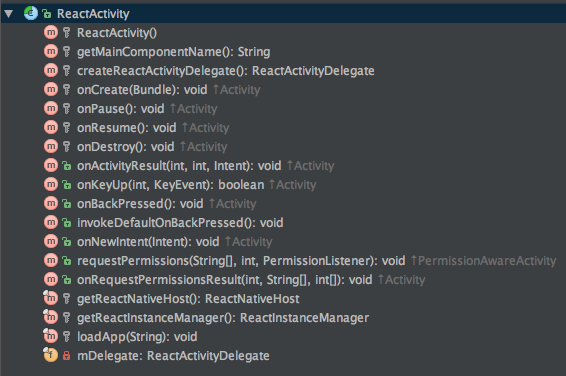
根据上述的结构转换成 UML 图如下(后面相关类将直接给出 UML ):
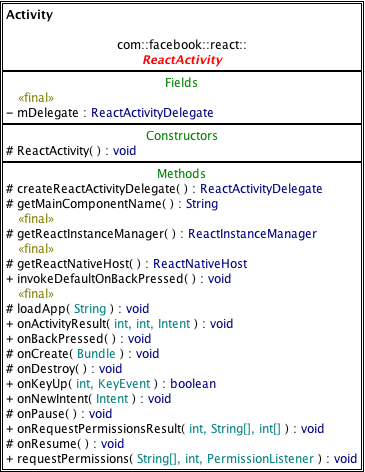
这里使用了委托模式将 Activity 的生命周期及事件传递委托给 ReactActivityDelegate 的实例对象 mDelegate 进行处理,之所以使用这种形式是为了让 ReactFragmentActivity 也能复用该处理逻辑。
此外如果你有自定义的委托实现,可以在自己的 Activity 中覆写 createReactActivityDelegate() 方法。这个方法将在 ReactActivity 的构造函数中调用生成 mDelegate 实例,之后在 onCreate() 方法调用这个委托对象的执行入口,也就是loadApp()方法。
ReactActivityDelegate
1
2
3
4
5
6
7
8
9
10
11
12
13
14
15
16
17
18
19
20
21
22
23
24
25
26
| public class ReactActivityDelegate {
protected void onCreate(Bundle savedInstanceState) {
if (getReactNativeHost().getUseDeveloperSupport() && Build.VERSION.SDK_INT >= 23) {
}
if (mMainComponentName != null) {
loadApp(mMainComponentName);
}
}
protected void loadApp(String appKey) {
mReactRootView = createRootView();
mReactRootView.startReactApplication(
getReactNativeHost().getReactInstanceManager(),
appKey,
getLaunchOptions());
getPlainActivity().setContentView(mReactRootView);
}
}
|
ReactRootView
因此可以认为所谓的 RN 其实就是一个特殊的“自定义 View ”– ReactRootView 。
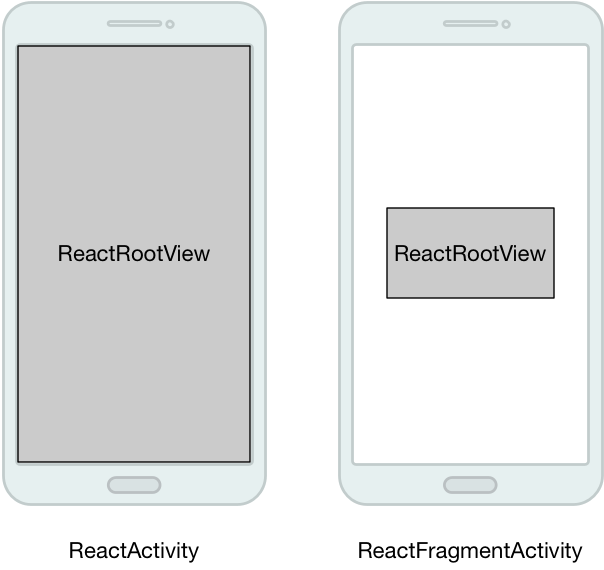
这里的关键调用则是 startReactApplication() 方法。下面是该方法需要的三个参数:
| 形参 |
类型 |
功能描述 |
| reactInstanceManager |
ReactInstanceManager |
用来创建及管理 CatalyInstance (提供原生与JS互调环境)的实例,同时连接调试功能,其生命周期与 ReactRootView 所在 Activity 保持一致。 |
| moduleName |
String |
即实参 appKey ,需要保证JS中的 AppRegistry.registerComponent 参数值与 Acitvity 中的 getMainComponentName 返回值一致。 |
| launchOptions |
Bundle(后续版本可能更改为POJO) |
默认为null,如果你需要传 Props 给 JS 的话,请覆写 createReactActivityDelegate() 方法,并覆写 getLaunchOptions() 的返回值即可。 |
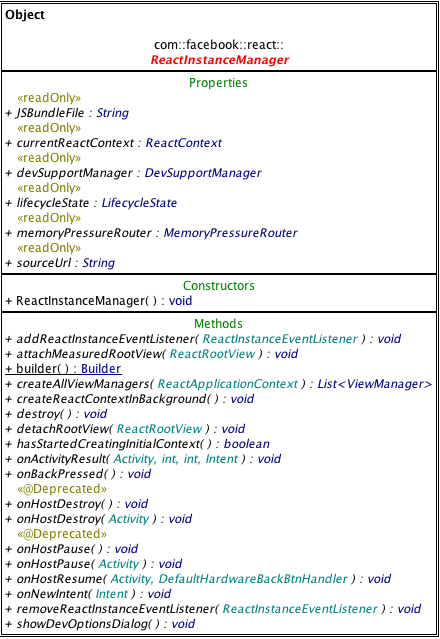
1
2
3
4
5
6
7
8
9
10
11
12
| public void startReactApplication(
ReactInstanceManager reactInstanceManager,
String moduleName,
@Nullable Bundle launchOptions) {
if (!mReactInstanceManager.hasStartedCreatingInitialContext()) {
mReactInstanceManager.createReactContextInBackground();
}
}
|
startReactApplication() 将调用其中的 createReactContextInBackground() 方法,我们下面来看看这个通过构造者模式创建的实现类– XReactInstanceManagerImpl 。
ReactInstanceManager
1
2
3
4
5
6
7
8
9
10
|
@Override
public void createReactContextInBackground() {
mHasStartedCreatingInitialContext = true;
recreateReactContextInBackgroundInner();
}
|
可以看到不管是 createReactContextInBackground() 还是 recreateReactContextInBackground() ,都是通过 recreateReactContextInBackgroundInner() 来初始化 ReactContext 的。
1
2
3
4
5
6
7
8
9
10
11
12
13
14
15
16
17
18
19
| private void recreateReactContextInBackgroundInner() {
if (mUseDeveloperSupport && mJSMainModuleName != null) {
return;
}
recreateReactContextInBackgroundFromBundleLoader();
}
private void recreateReactContextInBackgroundFromBundleLoader() {
recreateReactContextInBackground(
new JSCJavaScriptExecutor.Factory(mJSCConfig.getConfigMap()),
mBundleLoader);
}
}
|
| 形参 |
类型 |
功能描述 |
| jsExecutorFactory |
JavaScriptExecutor.Factory |
管理Webkit 的 JavaScriptCore,JS与C++的双向通信在这里中转 |
| jsBundleLoader |
JSBundleLoader |
bundle加载器,根据ReactNativeHost中的配置决定从哪里加载bundle文件 |
XReactInstanceManagerImpl
1
2
3
4
5
6
7
8
9
10
11
12
13
14
15
16
17
| private void recreateReactContextInBackground(
JavaScriptExecutor.Factory jsExecutorFactory,
JSBundleLoader jsBundleLoader) {
/ 把两个参数封装成ReactContextInitParams对象
ReactContextInitParams initParams =
new ReactContextInitParams(jsExecutorFactory, jsBundleLoader);
if (mReactContextInitAsyncTask == null) {
mReactContextInitAsyncTask = new ReactContextInitAsyncTask();
mReactContextInitAsyncTask.executeOnExecutor(AsyncTask.THREAD_POOL_EXECUTOR, initParams);
} else {
}
}
|
ReactContextInitAsyncTask
1
2
3
4
5
6
7
8
9
10
11
12
13
14
15
16
17
18
19
20
21
22
23
24
25
26
27
28
29
30
31
32
33
34
35
36
37
38
39
40
41
42
43
44
45
46
47
48
49
50
51
52
53
54
55
56
57
58
59
60
61
62
63
64
65
66
67
68
69
70
71
72
73
74
75
76
77
78
79
80
81
82
83
84
85
86
87
88
89
90
91
92
93
94
95
96
97
98
| private ReactApplicationContext createReactContext(
JavaScriptExecutor jsExecutor,
JSBundleLoader jsBundleLoader) {
JavaScriptModuleRegistry.Builder jsModulesBuilder = new JavaScriptModuleRegistry.Builder();
final ReactApplicationContext reactContext = new ReactApplicationContext(mApplicationContext);
if (mUseDeveloperSupport) {
reactContext.setNativeModuleCallExceptionHandler(mDevSupportManager);
}
try {
CoreModulesPackage coreModulesPackage =
new CoreModulesPackage(this, mBackBtnHandler, mUIImplementationProvider);
processPackage(
coreModulesPackage,
reactContext,
moduleSpecs,
reactModuleInfoMap,
jsModulesBuilder);
} finally {
}
for (ReactPackage reactPackage : mPackages) {
try {
processPackage(
reactPackage,
reactContext,
moduleSpecs,
reactModuleInfoMap,
jsModulesBuilder);
} finally {
}
}
NativeModuleRegistry nativeModuleRegistry;
try {
nativeModuleRegistry = new NativeModuleRegistry(moduleSpecs, reactModuleInfoMap);
} finally {
}
NativeModuleCallExceptionHandler exceptionHandler = mNativeModuleCallExceptionHandler != null
? mNativeModuleCallExceptionHandler
: mDevSupportManager;
CatalystInstanceImpl.Builder catalystInstanceBuilder = new CatalystInstanceImpl.Builder()
.setReactQueueConfigurationSpec(ReactQueueConfigurationSpec.createDefault())
.setJSExecutor(jsExecutor)
.setRegistry(nativeModuleRegistry)
.setJSModuleRegistry(jsModulesBuilder.build())
.setJSBundleLoader(jsBundleLoader)
.setNativeModuleCallExceptionHandler(exceptionHandler);
final CatalystInstance catalystInstance;
try {
catalystInstance = catalystInstanceBuilder.build();
} finally {
}
if (mBridgeIdleDebugListener != null) {
catalystInstance.addBridgeIdleDebugListener(mBridgeIdleDebugListener);
}
reactContext.initializeWithInstance(catalystInstance);
catalystInstance.runJSBundle();
return reactContext;
}
|
| 原生模块 |
功能描述 |
| AndroidInfoModule |
获取Android版本号和本地服务器地址 |
| AnimationsDebugModule |
监听动画过渡性能 |
| DeviceEventManagerModule |
事件监听,比如后退键 |
| ExceptionsManagerModule |
异常处理 |
| HeadlessJsTaskSupportModule |
通知部分JS任务执行完成 |
| SourceCodeModule |
传递Bundle文件地址 |
| Timing |
在绘制帧率变化时触发JS定时器 |
| UIManagerModule |
提供JS去创建和更新原生视图的能力 |
| DebugComponentOwnershipModule |
调试功能:异步请求视图结构 |
| JSCHeapCapture |
调试功能:获取堆内存信息 |
| JSCSamplingProfiler |
调试功能:dump工具 |
CatalystInstance
1
2
3
4
5
6
7
8
9
10
11
12
13
14
15
16
17
18
19
20
21
22
23
24
25
26
27
28
29
30
31
32
33
34
35
36
|
private CatalystInstanceImpl(
final ReactQueueConfigurationSpec ReactQueueConfigurationSpec,
final JavaScriptExecutor jsExecutor,
final NativeModuleRegistry registry,
final JavaScriptModuleRegistry jsModuleRegistry,
final JSBundleLoader jsBundleLoader,
NativeModuleCallExceptionHandler nativeModuleCallExceptionHandler) {
mReactQueueConfiguration = ReactQueueConfigurationImpl.create(
ReactQueueConfigurationSpec,
new NativeExceptionHandler());
initializeBridge(
new BridgeCallback(this),
jsExecutor,
mReactQueueConfiguration.getJSQueueThread(),
mReactQueueConfiguration.getNativeModulesQueueThread(),
mJavaRegistry.getModuleRegistryHolder(this));
mMainExecutorToken = getMainExecutorToken();
}
@Override
public void runJSBundle() {
mJSBundleHasLoaded = true;
mJSBundleLoader.loadScript(CatalystInstanceImpl.this);
}
|
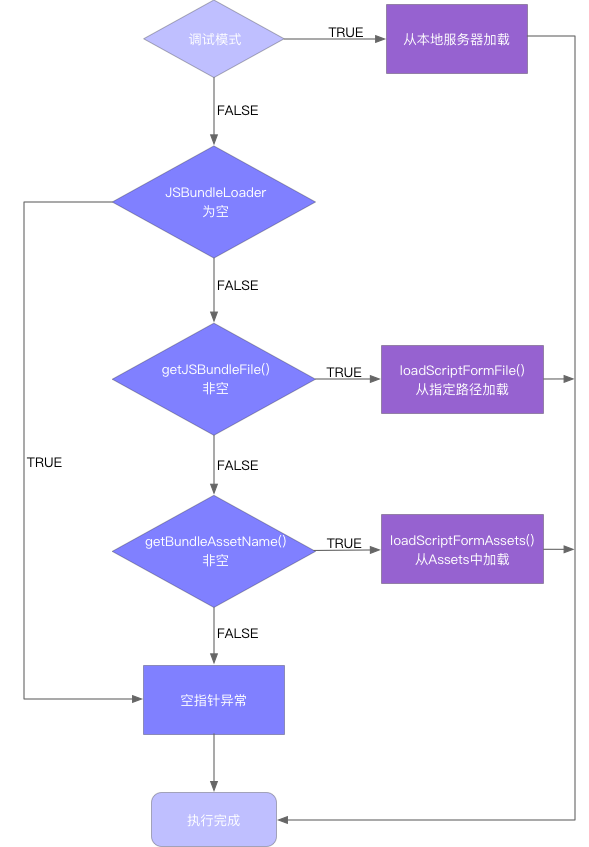
1
2
3
4
5
6
7
8
9
| private native void initializeBridge(ReactCallback callback,
JavaScriptExecutor jsExecutor,
MessageQueueThread jsQueue,
MessageQueueThread moduleQueue,
ModuleRegistryHolder registryHolder);
native void loadScriptFromAssets(AssetManager assetManager, String assetURL);
native void loadScriptFromFile(String fileName, String sourceURL);
native void loadScriptFromOptimizedBundle(String path, String sourceURL, int flags);
|
此时已经发现Java层的逻辑已经走完,不管是 CatalystInstance 实例的初始化还是 Bundle 的加载逻辑都将由 C++ 层进行处理。
CatalystInstance的创建
CatalystInstanceImpl.cpp 中是空实现,具体实现在 Instance.cpp 中。
1
2
3
4
5
6
7
8
9
10
11
12
13
14
15
16
17
18
19
20
21
22
23
24
25
26
27
28
29
|
void CatalystInstanceImpl::initializeBridge(
std::unique_ptr<InstanceCallback> callback,
std::shared_ptr<JSExecutorFactory> jsef,
std::shared_ptr<MessageQueueThread> jsQueue,
std::unique_ptr<MessageQueueThread> nativeQueue,
std::shared_ptr<ModuleRegistry> moduleRegistry) {
callback_ = std::move(callback);
jsQueue->runOnQueueSync(
[this, &jsef, moduleRegistry, jsQueue,
nativeQueue=folly::makeMoveWrapper(std::move(nativeQueue))] () mutable {
nativeToJsBridge_ = folly::make_unique<NativeToJsBridge>(
jsef.get(), moduleRegistry, jsQueue, nativeQueue.move(), callback_);
std::lock_guard<std::mutex> lock(m_syncMutex);
m_syncReady = true;
m_syncCV.notify_all();
});
CHECK(nativeToJsBridge_);
}
|
Bundle 的加载
1
2
3
4
5
6
7
8
9
10
11
12
13
14
15
16
17
18
19
20
21
22
| void CatalystInstanceImpl::loadScriptFromAssets(jobject assetManager,
const std::string& assetURL) {
const int kAssetsLength = 9;
auto sourceURL = assetURL.substr(kAssetsLength);
auto manager = react::extractAssetManager(assetManager);
auto script = react::loadScriptFromAssets(manager, sourceURL);
if (JniJSModulesUnbundle::isUnbundle(manager, sourceURL)) {
instance_->loadUnbundle(
folly::make_unique<JniJSModulesUnbundle>(manager, sourceURL),
std::move(script),
sourceURL);
return;
} else {
instance_->loadScriptFromString(std::move(script), sourceURL);
}
}
|
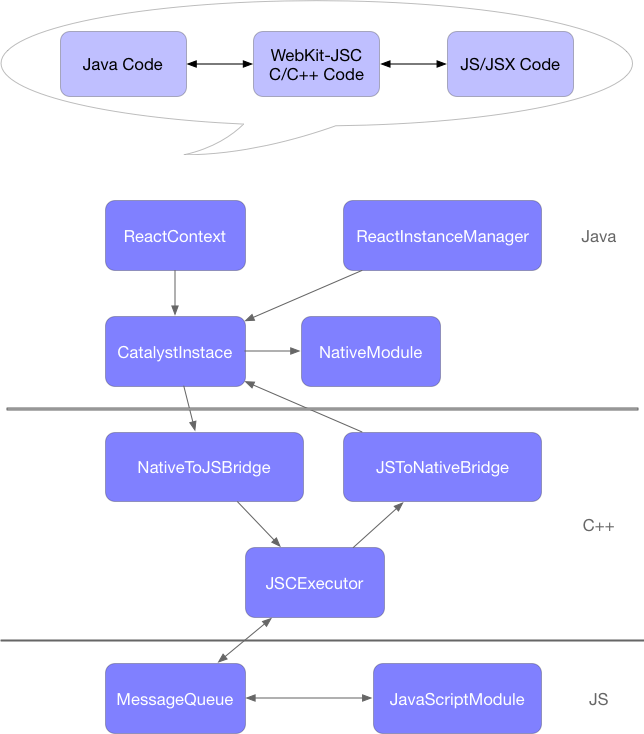
至此 C++ 层的调用逻辑到此为止,感兴趣的同学可以继续跟踪进入,或者可以参考文末的资料,我们下面假设底层执行完成,回到 ReactContextInitAsyncTask 的 onPostExecute 方法。
1
2
3
4
5
6
7
8
9
10
11
12
13
14
15
16
17
18
19
20
21
22
23
24
25
26
27
28
29
30
31
32
33
34
35
36
37
38
39
40
41
42
43
44
45
46
47
48
49
50
51
52
53
54
55
56
57
58
59
60
61
62
63
64
| @Override
protected void onPostExecute(Result<ReactApplicationContext> result) {
setupReactContext(result.get());
}
private void setupReactContext(ReactApplicationContext reactContext) {
Assertions.assertCondition(mCurrentReactContext == null);
CatalystInstance catalystInstance =
Assertions.assertNotNull(reactContext.getCatalystInstance());
catalystInstance.initialize();
mDevSupportManager.onNewReactContextCreated(reactContext);
mMemoryPressureRouter.addMemoryPressureListener(catalystInstance);
moveReactContextToCurrentLifecycleState();
for (ReactRootView rootView : mAttachedRootViews) {
attachMeasuredRootViewToInstance(rootView, catalystInstance);
}
}
private void attachMeasuredRootViewToInstance(
ReactRootView rootView,
CatalystInstance catalystInstance) {
rootView.removeAllViews();
rootView.setId(View.NO_ID);
UIManagerModule uiManagerModule = catalystInstance.getNativeModule(UIManagerModule.class);
int rootTag = uiManagerModule.addMeasuredRootView(rootView);
rootView.setRootViewTag(rootTag);
@Nullable Bundle launchOptions = rootView.getLaunchOptions();
WritableMap initialProps = Arguments.makeNativeMap(launchOptions);
String jsAppModuleName = rootView.getJSModuleName();
WritableNativeMap appParams = new WritableNativeMap();
appParams.putDouble("rootTag", rootTag);
appParams.putMap("initialProps", initialProps);
catalystInstance.getJSModule(AppRegistry.class).runApplication(jsAppModuleName, appParams);
}
|
AppRegistry
1
2
3
4
5
| public interface AppRegistry extends JavaScriptModule {
void runApplication(String appKey, WritableMap appParameters);
void unmountApplicationComponentAtRootTag(int rootNodeTag);
void startHeadlessTask(int taskId, String taskKey, WritableMap data);
}
|
AppRegistry 的 runApplication() 方法成为了加载 index.android.js 的主入口,而所有的 JS 方法调用都会经过 JavaScriptModuleInvocationHandler 。
JavaScriptModuleInvocationHandler
1
2
3
4
5
6
7
8
9
10
11
12
13
14
15
16
| @Override
public @Nullable Object invoke(Object proxy, Method method, @Nullable Object[] args) throws Throwable {
ExecutorToken executorToken = mExecutorToken.get();
NativeArray jsArgs = args != null ? Arguments.fromJavaArgs(args) : new WritableNativeArray();
mCatalystInstance.callFunction(
executorToken,
mModuleRegistration.getName(),
method.getName(),
jsArgs
);
return null;
}
|
以上就是 RN Android 的执行主流程,如有疏漏,欢迎留言。
参考资料
- https://github.com/facebook/react-native
- ReactNative Android源码分析
- React Native Android 源码框架浅析(主流程及 Java 与 JS 双边通信)
- React Native通讯原理
- ReactNativeAndroid源码分析-Js如何调用Native的代码





